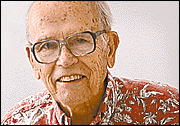


Hawaii’s World
WHEN 1,500 people jammed the Coral Ballroom at the Hilton Hawaiian Village to help the Chamber of Commerce of Hawaii honor the state's first home-grown four-star general, Eric K. Shinseki, I was in the back row, relegated to seeing him primarily on one of two big TV screens. Shinseki shows he has
the right stuffYet somehow I got the same thrill of waking up to true greatness in a "local boy" that I got in 1968 when Daniel K. Inouye showed himself to be world class at that year's raucous Democratic National Convention in Chicago.
Inouye did it first with a resounding keynote speech, then by keeping order as temporary chairman although the permanent chairman who succeeded him, House Speaker Carl Albert, could not.
Shinseki's challenge was not that great but the U.S. Army's first-ever Japanese-American chief of staff, a 1960 graduate of Kauai High School, radiated self-assurance and leadership just as Inouye had.
He told of a meeting in Singapore just before coming here where the word was delivered face-to-face to Indonesia's top general that the U.S. and army chiefs from 18 other countries assembled saw the end of violence in East Timor as their challenge, too.
He spoke of soldiers' duty to their country and of Army leaders' duty to their soldiers. His clipped words underlined that here is a general who will lead an army that is sharp and will send no one into combat untrained. His own past includes two wounds in Vietnam and Bronze Stars awarded with V's for valor.
I had dared to think Shinseki's selection might have had a nudge from Inouye, now a powerful voice in the Senate, but this man needs no nudge from anyone. He will lead the Army to new pride and new sharpness, or I will eat my visor hat.
I remembered that I wondered how the Army had surfaced a little-known general named Norman Schwarzkopf to lead the successful Gulf War in 1990-91. Were we just lucky?
No way, I was assured then by an old friend and former Star-Bulletin reporter, Allen K. Ono, who had just retired with three stars as the Army's deputy chief of staff for personnel. Ono now is an executive vice president of American Savings Bank. He got an Army commission in 1955 by way of the University of Hawaii. Shinseki graduated from West Point 10 years later.
Ono explained the selection process on the way to Army commands. Career assignments are varied, with each one a building block toward wider understanding of the Army.
Fitness reports are filed each year on each officer. They deal with character, know-how and leadership ability. If their commanders change in mid-year, additional fitness reports are filed. Thus immense detail is available for key personnel selections.
Shinseki, long seen as a comer, became the first-ever AJA commander of the 465,000 soldiers in the Army by way of a nomination from President Clinton and an easy confirmation by the Senate.
Last year at an AJA veterans' reunion and again before the Chamber of Commerce, Shinseki said he and Ono "stood on the shoulders" of the World War II AJAs who faced up to prejudice with remarkable patriotism and heroism. He has called Ono his mentor. Ono says he only told Shinseki: "Do good."
Shinseki praised the Kauai community he had grown up in for shaping him and welcomed friends he had not seen for over 30 years.
He concluded by buying into the wisdom of a soldier who told him: "If I had to do it all over again I'd marry the same woman and I'd join the United States Army." Shinseki's wife, Patty, also is from Kauai and a former schoolteacher.
A.A. Smyser is the contributing editor
and former editor of the the Star-Bulletin
His column runs Tuesday and Thursday.